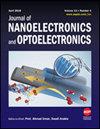Synthesis and Characterization of BaO-Enhanced Therm500 Nanofluids
IF 0.6
4区 工程技术
Q4 ENGINEERING, ELECTRICAL & ELECTRONIC
引用次数: 0
Abstract
In this study, we enhance the thermal conductivity of the conventional heat transfer fluid Therm500 by incorporating BaO nanoparticles. BaO:Therm500 nanofluids are synthesized and characterized at various concentrations (ranging from 0.001 to 0.006 g) and temperatures (300 K, 303 K, 313 K, and 323 K). The investigation includes the use of FT-IR spectroscopy to analyze the interaction between BaO nanoparticles and Therm500. Our findings indicate that there is no significant particle-fluid interaction. The enhanced thermal conductivity observed in BaO:Therm500 nanofluids is attributed to multiple factors. As the temperature increases, the viscosity of the nanofluid decreases, resulting in increased Brownian motion of nanoparticles and convective-like effects, ultimately leading to improved thermal conductivity. Additionally, we report the acoustic properties of BaO-Enhanced Therm500 nanofluids at the same four temperatures (300 K, 303 K, 313 K, and 323 K). Density, refractive index, and ultrasonic velocity measurements are performed for six different molar concentrations of BaO nanofluids (0.001 g, 0.002 g, 0.003 g, 0.004 g, 0.005 g, and 0.006 g). Subsequently, various acoustical parameters, such as adiabatic compressibility (β), intermolecular free length (Lf ), specific acoustic impedance (Z), Rao’s constant (R), molar compressibility (W), viscous relaxation time (τ), free volume (Vf ), Gibbs free energy (ΔG), and internal pressure (πi), are calculated. These acoustical characteristics are utilized to investigate molecular interactions within the nanofluid system. The study reveals a non-linear relationship between ultrasonic velocity and particle concentration, which is attributed to weak particle-fluid interactions. These findings provide valuable insights into the preparation and characterization of BaO-enhanced Therm500 nanofluids and their potential applications in heat transfer systems.氧化钡增强型 Therm500 纳米流体的合成与表征
在本研究中,我们通过加入 BaO 纳米粒子提高了传统导热流体 Therm500 的热导率。我们合成了 BaO:Therm500 纳米流体,并在不同浓度(0.001 至 0.006 克)和温度(300 K、303 K、313 K 和 323 K)下对其进行了表征。调查包括使用傅立叶变换红外光谱分析 BaO 纳米粒子和 Therm500 之间的相互作用。我们的研究结果表明,粒子与流体之间没有明显的相互作用。在 BaO:Therm500 纳米流体中观察到的热导率增强可归因于多种因素。随着温度的升高,纳米流体的粘度降低,导致纳米粒子的布朗运动和对流效应增加,最终提高了热导率。此外,我们还报告了 BaO 增强 Therm500 纳米流体在相同四个温度(300 K、303 K、313 K 和 323 K)下的声学特性。对六种不同摩尔浓度的 BaO 纳米流体(0.001 g、0.002 g、0.003 g、0.004 g、0.005 g 和 0.006 g)进行了密度、折射率和超声波速度测量。随后,计算了各种声学参数,如绝热可压缩性 (β)、分子间自由长度 (Lf)、比声阻抗 (Z)、拉奥常数 (R)、摩尔可压缩性 (W)、粘性弛豫时间 (τ)、自由体积 (Vf)、吉布斯自由能 (ΔG) 和内压 (πi)。利用这些声学特性来研究纳米流体系统内的分子相互作用。研究揭示了超声波速度与颗粒浓度之间的非线性关系,这归因于微粒与流体之间的微弱相互作用。这些发现为制备和表征 BaO 增强 Therm500 纳米流体及其在传热系统中的潜在应用提供了宝贵的见解。
本文章由计算机程序翻译,如有差异,请以英文原文为准。
求助全文
约1分钟内获得全文
求助全文
来源期刊

Journal of Nanoelectronics and Optoelectronics
工程技术-工程:电子与电气
自引率
16.70%
发文量
48
审稿时长
12.5 months
 求助内容:
求助内容: 应助结果提醒方式:
应助结果提醒方式:


